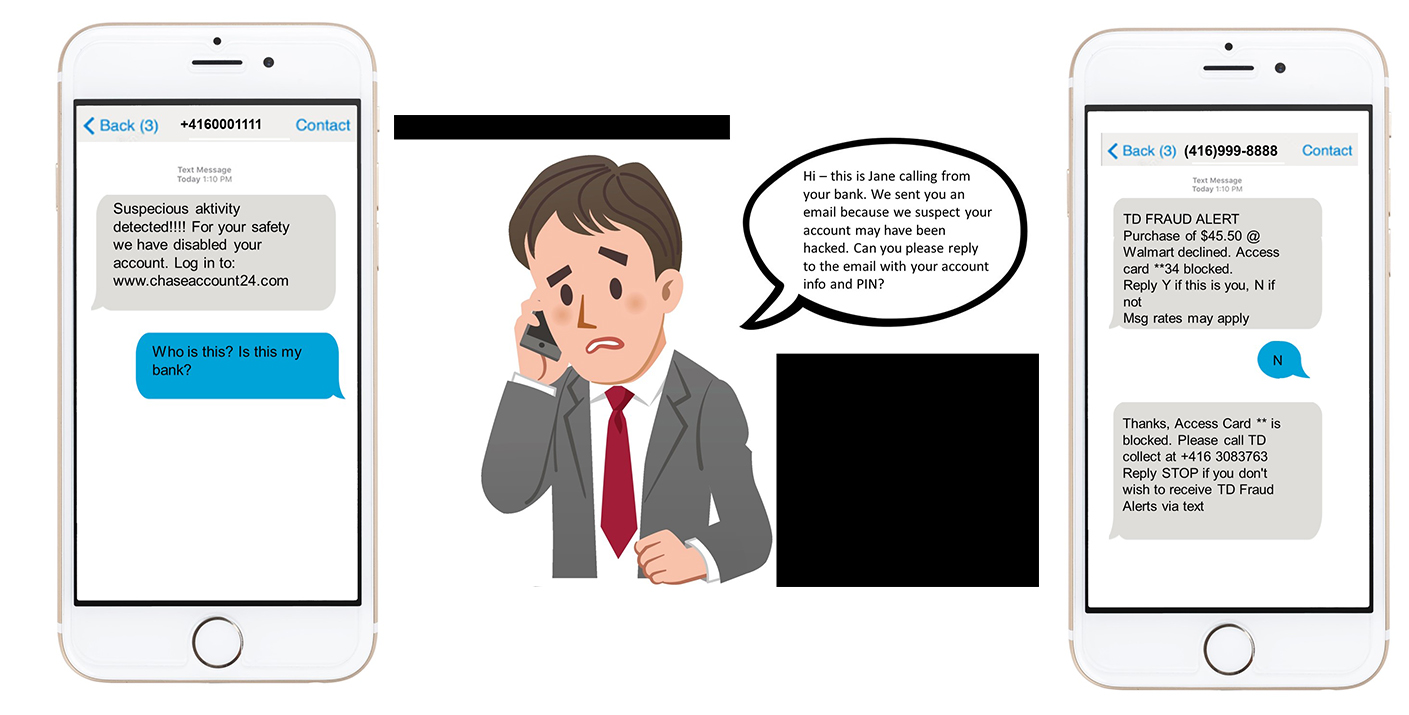Fraud Risk During the Holidays and How to Prevent It

Not only are the holidays a busy time for our schedules, but we also can’t deny that this is one of the busiest times of the year for our wallets. Whether it’s grocery shopping for Christmas dinner, or shopping the malls for the perfect gift for a loved one, we can’t help but reach for our credit and debit cards.
With that however, it is easy to become a target for fraud and scams. I’m sure we can all admit to receiving a sketchy email or text message claiming that our bank needs information, or noticing strange activity on your bank statement? And as real as they may look, it is a common form of fraud and/or identity theft, so it is necessary to know how to prepare yourself for such situations, as well as knowing how to avoid them.

This is not only something you need to control, but working with your bank is the smartest way to prevent such issues from taking place. As a TD customer, I now feel secure in understanding the difference between scams and legitimate fraud alerts, however I understand the “but what if its real” feeling when a call, email or text come through regarding your banking information.
During the busy rush of holiday shopping, you can get hit with identity theft or become a victim of credit or debit card fraud, which in that case, means that you need to contact your bank right away. However, there are a few things you can look out for to help you identify that it is taking place:
Texts:
- What: Text messages sent to your cell phone using SMS (Short Message Service) technology in an attempt to trick you into providing your personal information. The message may include a link what looks like a legitimate website address and asks you to enter several pieces of your personal financial information, such as your credit/debit card number, CVV code on the back of your credit card, your SIN, your e-mail address or other personal information.
- Watch outs: Often, there are spelling and grammatical errors in the text message – not always a red flag for fraud, but it should alert you to watch for other signs. Hyperlinks in the message could also be a flag.
- Test your smishing knowledge: Can you detect a fraudulent text message?
- It’s the image below with:
- Overuse of exclamation marks
- Improper grammar
- Request to click on a website link.

E-Mail:
- What: Authentic-looking e-mails appearing to come from legitimate companies in an effort to “fish” or “phish” for personal and financial information. The emails direct customers to click on links that re-direct them to fraudulent or “spoofed” websites. Once on the fraudulent site, the customer is asked to enter personal and/or financial information that is later used to commit fraud.
- Watch outs: You should not be asked to reply to an email with personal information, login information such as usernames, passwords, PINs, Identification Plus security questions and answers, or account numbers because unencrypted e-mail is not secure. If you receive an email claiming to be from a financial institution and you believe it to be fraudulent, do not respond and do not open or click on any links or open attachments contained within the email. If you are asked to contact a financial institution, you should find the contact information independently.
- Test your phishing knowledge: Can you detect which is the fraudulent email? That’s right, it’s the first image of an e-mail prompting you to click on a link to an unsecure website.
Telephone:
- What: Telephone communications made to trick you into providing your personal information (i.e. credit/debit card number, your SIN, your e-mail address). They will be used to strengthen a phishing expedition.
- Watch outs: Customers should not receive requests for personal information by unsolicited telephone calls. If you suspect the call may not be from a legitimate financial institution, tell them you want to call them back through the toll-free number on the back of the card.
- Test your vishing knowledge: Can you detect a fraudulent phone call? Is it an unsolicited phone call? Are they asking you for personal information over the phone?
The first step to preventing fraud is recognizing these different approaches, especially during this busy season, but I appreciate how much support I receive from my bank to help prevent suspicious activity.

I no longer get blindsided by fake messages since TD has a unique feature where it sends its Canadian customers free fraud alerts via text where you can reply to the alert with a simple “Y” or “N” to confirm whether you recognize the transaction and have TD unblock or block your card without having to share personal information. And also, using the TD MySpend app helps keep me aware of all account purchases and transactions. That means I’m getting real-time notifications, so any issues or suspicions can be assessed immediately.

I can now feel comfortable knowing that TD has my back and not only helps secure my account, but keeps me up to date when things get awry. Who doesn’t need that, right?
For more information on TD alerts and how I am staying safe with my bank this holiday season, visit here. Happy shopping!
*Minimize your risk: The information above is provided to help you protect yourself, but it’s not foolproof: it’s a fast paced and constantly changing world so make sure you are keeping up-to-date on and monitoring security features and preventative measures to minimize your risk of fraud.
This post has been sponsored by TD Bank. All opinions are my own.




 Follow
Follow






COMMENTS ARE OFF THIS POST